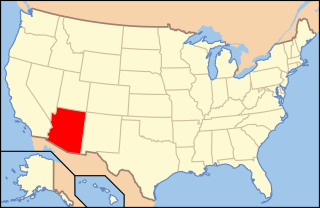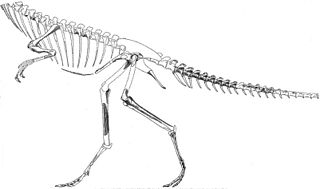 W
WPaleontology in Arizona refers to paleontological research occurring within or conducted by people from the U.S. state of Arizona. The fossil record of Arizona dates to the Precambrian. During the Precambrian, Arizona was home to a shallow sea which was home to jellyfish and stromatolite-forming bacteria. This sea was still in place during the Cambrian period of the Paleozoic era and was home to brachiopods and trilobites, but it withdrew during the Ordovician and Silurian. The sea returned during the Devonian and was home to brachiopods, corals, and fishes. Sea levels began to rise and fall during the Carboniferous, leaving most of the state a richly vegetated coastal plain during the low spells. During the Permian, Arizona was richly vegetated but was submerged by seawater late in the period.
 W
WThe Arizona Museum of Natural History is the only natural history museum in the greater Phoenix area and is located in Mesa, Arizona. It exhibits the natural and cultural history of the Southwestern United States.
 W
WCamposaurus is a coelophysoid dinosaur genus from the Norian stage of the Late Triassic period of North America. The pertinent fossil remains date back to the early to middle Norian stage, and is widely regarded as the oldest known neotheropod.
 W
WThe Carmel Formation is a geologic formation in the San Rafael Group that is spread across the U.S. states of Wyoming, Utah, Colorado, north east Arizona and New Mexico. Part of the Colorado Plateau, this formation was laid down in the Middle Jurassic during the late Bajocian, through the Bathonian and into the early Callovian stages.
 W
WCoelophysis kayentakatae is an extinct species of coelophysid dinosaur that lived approximately 196 million years ago during the early part of the Jurassic Period in what is now the southwestern United States. Originally included in the genus Syntarsus, it has been reclassified as Coelophysis along with the African species, Coelophysis rhodesiensis.
 W
WThe Double Adobe Site is an archaeological site in southern Arizona, twelve miles northwest of Douglas in the Whitewater Draw area. In October 1926, just three months after the first human artifact was uncovered at the Folsom Site, Byron Cummings, first Head of the Archaeology Department at the University of Arizona, led four students to Whitewater Draw. Discovered by a schoolboy, the Double Adobe site contained the skull of a mammoth overlying a sand layer containing stone artifacts. One of these students was Emil Haury.
 W
WKayenta, Arizona is a settlement in the Navajo reservation.
 W
WKayentavenator is a genus of small carnivorous dinosaur that lived during the Early Jurassic Period; fossils were recovered from the Kayenta Formation of northeastern Arizona and were described in 2010.
 W
WThe Lehner Mammoth-Kill Site is a location in southern Arizona that is significant for its association with evidence that mammoths were killed here by Paleo-Indians 9000 years BCE.
 W
WThe Museum of Northern Arizona is a museum in Flagstaff, Arizona, United States, that was established as a repository for Indigenous material and natural history specimens from the Colorado Plateau.
 W
WThe Naco Mammoth Kill Site is an archaeological site in southeast Arizona, near Naco, Arizona. The site was reported to the Arizona State Museum in September 1951 by Marc Navarrete, a local resident, after his father found two Clovis points in Greenbush Draw, while digging out the fossil bones of a mammoth. Emil Haury excavated the Naco mammoth site in April 1952. In only five days, Haury recovered the remains of a Columbian Mammoth that had been killed by the use of at least 8 Clovis points about 10,000 years ago. The Naco site was the first Clovis mammoth kill association to be identified.
 W
WThe Navajo Sandstone is a geological formation in the Glen Canyon Group that is spread across the U.S. states of southern Nevada, northern Arizona, northwest Colorado, and Utah as part of the Colorado Plateau province of the United States.
 W
WPetrified Forest National Park is an American national park in Navajo and Apache counties in northeastern Arizona. Named for its large deposits of petrified wood, the park covers about 346 square miles, encompassing semi-desert shrub steppe as well as highly eroded and colorful badlands. The park's headquarters is about 26 miles (42 km) east of Holbrook along Interstate 40 (I-40), which parallels the BNSF Railway's Southern Transcon, the Puerco River, and historic U.S. Route 66, all crossing the park roughly east–west. The site, the northern part of which extends into the Painted Desert, was declared a national monument in 1906 and a national park in 1962. The park received 644,922 recreational visitors in 2018.
 W
WProsalirus is the name given to a fossilized prehistoric frog found in the Kayenta Formation of Arizona in 1981 by Farish Jenkins. The type, and currently only, species is Prosalirus bitis.
 W
WSarahsaurus is a genus of basal sauropodomorph dinosaur which lived during the lower Jurassic period in what is now northeastern Arizona, United States.
 W
WSegisaurus is a genus of small coelophysoid theropod dinosaur, that measured approximately 1 metre in length. The only known specimen was discovered in early Jurassic strata in Tsegi Canyon, Arizona, for which it was named. Segisaurus is the only dinosaur to have ever been excavated from the area.
 W
WSonorasaurus is a genus of brachiosaurid dinosaur from the Early to Late Cretaceous. It was a herbivorous sauropod whose fossils have been found in southern Arizona in the United States. Its name, which means "Sonora lizard", comes from the Sonoran Desert where its fossils were first found. The type species is S. thompsoni, described by Ratkevich in 1998.
 W
WThe Summerville Formation is a geological formation in New Mexico, Colorado, and Utah of the Southwestern United States. It dates back to the Oxfordian stage of the Late Jurassic.
 W
WVentana Cave is an archaeological site in southern Arizona. It is located on the Tohono O'odham Indian Reservation. The cave was excavated under the direction of Emil Haury by teams led by Julian Hayden in 1942, and in 1941 by a team led by Wilfrid C Bailey, one of Emil Haury's graduate students. The deepest artifacts from Ventana Cave were recovered from a layer of volcanic debris that also contained Pleistocene horse, Burden's pronghorn, tapir, sloth, and other extinct and modern species. A projectile point from the volcanic debris layer was compared to the Folsom Tradition and later to the Clovis culture, but the assemblage was peculiar enough to warrant a separate name – the Ventana Complex. Radiocarbon dates from the volcanic debris layer indicated an age of about 11,300 BP.
 W
WVigilius is an extinct genus of brachyopid temnospondyl amphibian from the Triassic of Arizona. It is known from the single type species Vigilius wellesi.